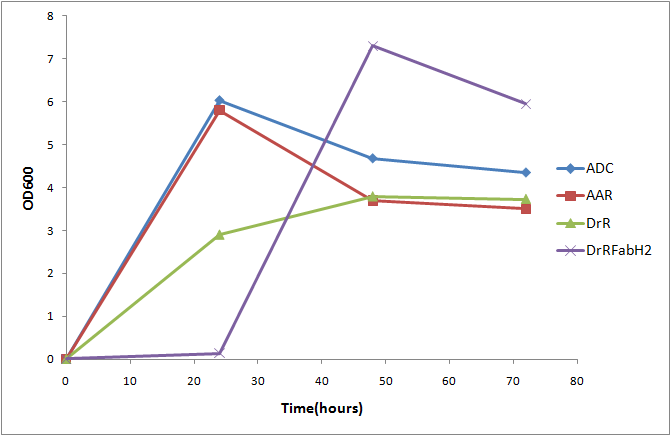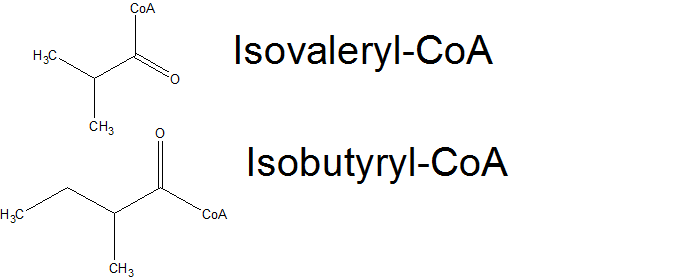Team:Washington/Alkanes/Future/FabH2
From 2011.igem.org
| Line 26: | Line 26: | ||
3. Branched-chain fatty acid biosynthesis in Escherichia coli. Smirnova N, Reynolds KA. J Ind Microbiol Biotechnol. 2001 Oct;27(4):246-51. | 3. Branched-chain fatty acid biosynthesis in Escherichia coli. Smirnova N, Reynolds KA. J Ind Microbiol Biotechnol. 2001 Oct;27(4):246-51. | ||
| + | |||
=Parts Submitted= | =Parts Submitted= | ||
Revision as of 02:26, 29 September 2011
Background
The basic alkane production system is incapable of making branched chain alkanes, as E. coli normally only makes straight chain fatty acids. We thought that if we could engineer alkane producing E. coli that also makes alkanes, we could make branched chain alkanes, a significant proportion of diesel( [2]). One protein whose expression has been previously shown ( [1]) to cause E. coli to produce branched chain fatty acids is FabH2 from Bacillus subtilis. The FabH family of proteins initiates fatty acid elongation by converting an Acyl-CoA into an Acyl-ACP, with is extended by 2 carbon units to form longer chain length fatty acids. Normally, FabH proteins use a simple 2-carbon acetyl-CoA to start fatty acid biosynthesis, resulting in linear fatty acids. However, FabH2 can also use Isobutyryl-CoA and Isovaleryl-CoA( products from Valine and Leucine degredation), resulting in 2-methyl branched fatty acid production. If we could use FabH2 and the Petrobrick to get E. coli to produce both alkanes and branched chain fatty acids, we should theoretically be able to produce 2-methyl branched alkanes.
Methods
[http://partsregistry.org/wiki/index.php?title=Part:BBa_K590034 FabH2 ] was constructed from oligos( refer to protocol). FabH2 was then amplified to add an [http://partsregistry.org/wiki/index.php?title=Part:BBa_B0034 Elowitz standard RBS]. This RBS-FabH2 construct was cloned into the 3' end of [http://partsregistry.org/wiki/index.php?title=Part:BBa_K590025 the PetroBrick] to express [http://partsregistry.org/wiki/index.php?title=Part:BBa_K590030 FabH2 as well as AAR and ADC].
Current Results
Throughout our experiments, we observed that cells expressing FabH2 grew significantly slower than any of our other alkane producing cells. In order to quantify this effect, we measured OD600 for alkane production constructs every 24 hours for a 72 hour period, producing a growth curve.

After 24 hours, FabH2 producing cells had barely grown at all, indicating a severe growth deficiency. The cells were able to rapidly grow after 24 hours, presumably due to a mutation that counteracted the negative effects of FabH2. This toxicity could be due to branched chain fatty acid production, or due to the activity of FabH2 on straight chain substrates. Since we haven't yet been able to observe branched chain-alkane, or branched chain fatty acid production, we do not know which of these two possibilities are causing this toxicity. However, this severe growth deficiency implies that FabH2 is being expressed, and has activity that is detrimental to cell growth. As of now, we have not been able to produce branched chain fatty alkanes. It is unlikely that this is due to the inability of AAR/ADC to act on branched chain substrates, due to the wide specificity of these two enzymes. Another possibility is that no proper substrates are being produced. Based upon further research,we determined that E. coli does not natively make Isobutyryl-CoA or isovaleryl-CoA. We cannot figure out how ( [1]) was able to produce branched chain fatty acids, as E. coli doesn't natively make branched chain CoAs( as far as we can find). Further evidence to support this assumption is found in [3], which showed that E. coli needs to be supplemented with branched CoAs to produce branched chain fatty acids. If no branched chain fatty acid production is occurring, we do not know why FabH2 causes a severe growth deficiency. It is possible that the activity of FabH2 on linear CoAs may be having some negative metabolic effect. Future work will consist of cloning genes that result in branched chain-CoA formation into E. coli expressing the PetroBrick and FabH2. This will hopefully result in branched chain alkane production.
References
1.Beta-ketoacyl-acyl carrier protein synthase III (FabH) is a determining factor in branched-chain fatty acid biosynthesis. Choi KH, Heath RJ, Rock CO. J Bacteriol. 2000 Jan;182(2):365-70.
2. http://www.dtic.mil/cgi-bin/GetTRDoc?AD=ADA317177&Location=U2&doc=GetTRDoc.pdf
3. Branched-chain fatty acid biosynthesis in Escherichia coli. Smirnova N, Reynolds KA. J Ind Microbiol Biotechnol. 2001 Oct;27(4):246-51.
Parts Submitted
[http://partsregistry.org/wiki/index.php?title=Part:BBa_K590034 FabH2] This part contains the FabH2 coding sequence, codon optimized for E. coli
[http://partsregistry.org/wiki/index.php?title=Part:BBa_K590030 FabH2-ADC-AAR] This part expresses FabH2, as well as AAR and ADC, the two genes responsible for alkane production.
 "
"



